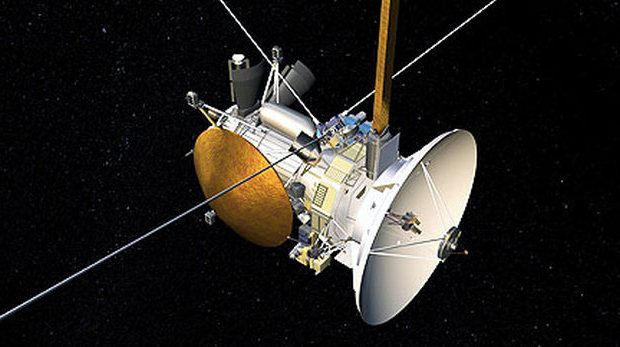Bearing the resemblance of a vinyl record, the rings of Saturn make this planet undoubtedly the most gracious of all planets of our solar system. A glance through a small telescope at the planet Saturn is often the experience that turns people on to astronomy. Simply walking outside, setting up a little scope, and enjoying a spectacular view of a distant planet, colorful and beautiful, surrounded by razor-sharp rings, is deeply satisfying.
Saturn’s rings were also one of the first targets of Galileo Galilei’s new telescope some 400 years ago when he revolutionized human observations of the cosmos. Among the most identifiable and familiar symbols of astronomy, Saturn’s rings remain almost as mysterious today as they were to that Italian explorer.
Saturn’s globe measures 120,590 km across; its rings span 483,000 km
Scientists don’t yet know the origin of the rings. In 1980 and 1981, scientists got their first great view of Saturn’s rings when the Voyager 1 and 2 spacecraft conducted scientific operations up close. Saturn’s globe measures 74,900 miles (120,590 km) across; its rings span 300,000 miles (483,000 km). The rings are divided into groups, designated C, B, and A, working outward from the planet. Visible in a small telescope is the black band that separates rings B and A called the Cassini Division, after Giovanni Cassini, who discovered the gap in 1675.
the rings comprise countless thousands of particles of dirty water ice ranging from microns to meters in size
Astronomers continue to discover fainter rings. They are designated D (closest to the planet), F (a narrow feature just outside the A ring), and two distant rings called G and E. The early view of Saturn’s rings as a continuous flat disk like a CD has changed, courtesy of the Voyagers. Today, astronomers realize the rings comprise countless thousands of particles of dirty water ice ranging from microns to meters in size. The Voyagers found surprising structures in the rings.
Unresolved ringlets and gaps might be caused by tiny satellites orbiting within the rings, astronomers reasoned. By observing stars behind Saturn’s rings, Voyager resolved objects as small as 1,000 feet (305 meters) across and showed that few gaps exist in certain rings. Instead, density waves create the effect. Some of the rings contain clumps and spokes. In the wake of the Voyagers, many unanswered questions remained.
there could be a possibility of life on Saturn’s largest moon – Titan.
The next chapter in Saturn exploration began in 2004 when the Cassini-Huygens spacecraft entered Saturnian orbit. The mission at Saturn continues; Cassini has taken a vast amount of data and produced thousands of images, and the European Huygens probe touched down on Saturn’s largest moon, Titan. Researchers have even suggested that there could be a possibility of life on Titan. Careful analysis of Saturn’s rings remains an ongoing project.

In April 2006, Cassini findings shed some light on the origin of the ring system. Strangely shaped gaps in some of the rings suggest elusive moonlets exist and support the notion that the rings are debris from an icy moon that broke up eons ago as a result of a violent collision. The scenario may be that, about 100 million years ago, a comet or asteroid slammed into an icy moon, breaking it into pieces. Saturn’s titanic gravity smoothed out the pieces into a flattened disk around the planet.
In April 2013, there was a hurricane on Saturn of intensity that was 20 times that of the hurricanes on Earth.
The idea is not confirmed, and Cassini will continue to collect vast amounts of additional data. In April 2013, Cassini had sent some really interesting images which indicated that there was a hurricane on Saturn at its North Pole and its intensity was 20 times that of the hurricanes which take place on Earth.
What caused it is still a mystery. There is no ocean beneath the hurricane which has puzzled the scientists. On July 19th, 2013 Cassini was pointed towards Earth to take photographs of both the Earth and the Moon. This was a very unique and special event as it was the first time that NASA had announced such a photo was being taken in advance. Check out this cool NASA video of the Saturn hurricane.
The origin of the rings is finally beginning to come into focus. Yet there are many questions which are still to be answered.
-end-


































